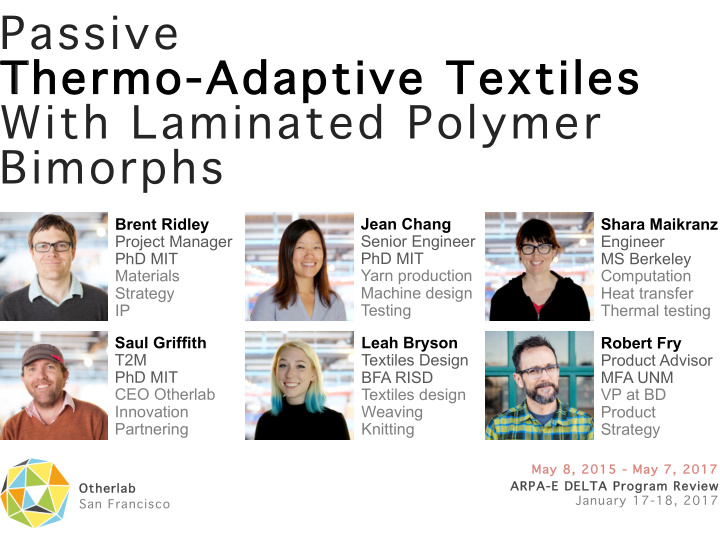



Passive The Thermo-Ada Adapti ptive e Te Textiles s With Laminated Polymer Bimorphs Jean Chang Brent Ridley Shara Maikranz Project Manager Senior Engineer Engineer PhD MIT PhD MIT MS Berkeley Materials Yarn production Computation Machine design Strategy Heat transfer IP Testing Thermal testing Saul Griffith Leah Bryson Robert Fry T2M Textiles Design Product Advisor PhD MIT BFA RISD MFA UNM CEO Otherlab Textiles design VP at BD Innovation Weaving Product Partnering Knitting Strategy May 8, 2015 - Ma Ma May 7, 2017 ARPA-E AR E DEL DELTA Program Rev eview ew Otherla Oth lab January 17-18, 2017 San Francisco
Resp Re sponsi onsive Insul Insulation V on Value ue 2.0 Measured Thermal Resistance (clo) 1.5 insulation increases 1.0 as temperature decreases 0.5 0.0 -15 -10 -5 0 5 10 15 20 Ambient Air Temperature (ºC) AR ARPA-E E DEL DELTA Program Rev eview ew Otherla Oth lab January 17-18, 2017 San Francisco
Activati Acti tion Tem empera peratu ture re 500% 4x 400% Relative Fabric Thickness 3x 300% 2x 200% 1x 100% activation temperature shift 0% 10 15 20 25 30 35 40 Fabric Temperature (ºC) AR ARPA-E E DEL DELTA Program Rev eview ew Otherla Oth lab January 17-18, 2017 San Francisco
Des Descript criptio ion of Tech echnolo logy gy Inspired By Bimorphs Pair two materials together Differential expansion causes bending Motion limited by ∆CTE Motion limited by structure Motion limited by process Timoshenko J Opt Soc Am 1925 AR ARPA-E E DEL DELTA Program Kick ckoff Oth Otherla lab AR ARPA-E E DEL DELTA Program Rev eview ew May 21-22, 2015 San Francisco January 17-18, 2017
Cha Challeng nges Beyond Bimorphs Passively responsive textiles require ordering and coordination at three different length scales nm – molecular µm – yarn mm – textile There are millions of fibers in a typical shirt – actuators must be cheap enough and small enough to integrate into yarn and fabric Start with commodity materials already used in textiles Fibers and yarns are processed to control thermal expansion properties Actuators must behave cooperatively to meaningfully change fabric thickness in response to small temperature changes Textile structure is carefully designed Textile production and processing are carefully controlled AR ARPA-E E DEL DELTA Program Rev eview ew Oth Otherla lab January 17-18, 2017 San Francisco
Va Value Pr Prop oposi osition on Thermal Comfort + Energy Savings 30 Heat Transfer Rate Change With Ambient Temperature metabolic rate = 1.0 met = 58 W/m 2 20 Power Retained or Lost (W) 10 heavy office attire 0 thermally adaptive attire -10 full office attire -20 light office attire shorts and shirt -30 18 19 20 21 22 23 24 25 26 Air Temperature (ºC) AR ARPA-E E DEL DELTA Program Rev eview ew Otherla Oth lab January 17-18, 2017 San Francisco
Sum Summary Otherlab Has Made an Adaptive Fabric Fabric more than doubles its insulation in response to ∆T = 10 ºC Fabric doubles thickness in response to ∆T = 10 ºC Activation temperature can be controlled Made from commodity materials (polyester, nylon, cotton) Yarn and textile design and production carried out at Otherlab Otherlab Wants to Make Adaptive Garments Yarn and fabric production and quality control are essential Secondary performance characteristics need exploration and iteration First entry to market needs to be determined and product developed Thermal performance will need to be tuned for optimal comfort AR ARPA-E E DEL DELTA Program Rev eview ew Oth Otherla lab January 17-18, 2017 San Francisco
Recommend
More recommend